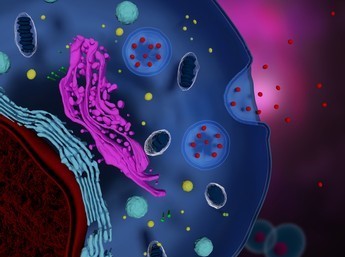Tissue Exosome Isolation Service
Exosomes are vesicle-like vesicles secreted extracellularly by cells between 30-150 mm in diameter, with a typical lipid bilayer structure. They can be found in cell culture supernatants, plasma, serum, saliva, urine, amniotic fluid, and malignant ascites, as well as in other biological fluids. It carries a wide range of proteins, lipids, DNA, and RNA from the mother cell and plays an important role in transferring material and information between cells.

Creative Biostructure can sample interstitial fluid (IF) in vivo without affecting the viability or morphology of tissue cells, a method for collecting exosomes from samples including tumors. This makes exosomes easy and reproducible to harvest and the way does not compromise tissue viability or morphology. After exosome isolation, tissue physiology and pathology remain intact and are fully compatible with all downstream tissue molecular assay procedures after extraction.
Our Methods for Tissue Exosome Isolation
- Ultracentrifugation. Time-consuming and labor-intensive, often taking 8-30 hours, processing up to 6 samples at a time, requiring large amounts of starting material and low yields. Requires an ultracentrifuge.
- Magnetic bead immunocapture. Using surface markers unique to the exosome surface (e.g., CD63, CD9 proteins), exosomes are adsorbed and isolated by incubating magnetic beads coated with anti-marker antibodies and binding to exosome vesicles. The magnetic bead method has the advantages of high specificity, and easy operation, and does not affect the morphological integrity of exosomes, but the efficiency is low and the biological activity of exosomes is easily affected by salt concentration, which is unfavorable for downstream experiments.
We have optimized the traditional method to isolate all subtypes of extracellular vesicles, including exosomes, from excised biopsies. Our method protects the tissue from destructive centrifugal forces and uses an isolation matrix to facilitate exosome extraction. This allows you to observe a highly reproducible enrichment of extracellular vesicles in IF to reveal previously unknown molecular insights.
Advantages of Tissue Exosome Isolation
- Excellent recovery of all subtypes of interstitial fluid exosomes.
- Extraction of IF exosomes take less than 10 minutes.
- Only a simple benchtop low-speed centrifuge is required to complete the extraction step.
- Fully compatible with all exosome isolation, purification, and characterization procedures.
- Suitable for all molecular targets such as RNA, DNA, proteins, lipids, etc.
Applications of Tissue Exosome Isolation
- Promote understanding and treatment of complex diseases through targeted tissue and extracellular analysis.
- Targeted exosomes can be used as novel biomarkers for precision medicine.
- To reveal features of tumor or host cell origin.
- For any downstream analytical assay.
Ordering Process
Creative Biostructure can extract exosomes from intact tissue in addition to using electron microscopy to analyze the size and morphology of exosomes, flow cytometry to analyze cell surface markers and fluorescent labeling to detect the origin of vesicles and classify them. If you are interested in the services we offer, please feel free to contact us for more information.
